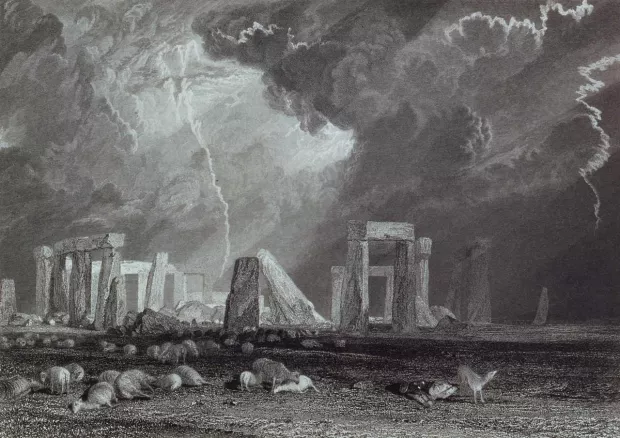Creation Date
1829
Height
25 cm
Width
31 cm
Medium
Genre
Description
Stonehenge has existed for thousands of years, making it a symbol of permanence and an indication of eras past difficult for humans to comprehend in their extensive entirety. In the Romantic era, a scholar named William Stukeley conjectured that it was constructed “not long after Cambyses’ invasion of Egypt,” which was about 525 B.C. (W. Stukeley, Stonehenge66; P. Briant, Cyrus to Alexander 55). The image, with its expansive sky and shadowed ground, suggests vast spaces beyond its boundaries, and the monument itself hints at its lengthy but inaccessible history.
This engraving is a plate in a book, Picturesque Views of England and Wales, first published in 1838. The original painting is part of a private collection and was likely painted for the purpose of being engraved.
A bank of thick clouds hovers over the standing stones, with sunlight shining through to illuminate the center of the monument. A flock of sheep grazes in the foreground on the course grass, some standing, most lying down. The horizon is nearly three-quarters of the way down the page, and the tops of the stones lie on a plane about halfway up the image.
Stonehenge combines the picturesque and the sublime, both important aspects of Romantic art. The detail in the image, the carefully arranged stones and sheep, and the various textures of the scene are all picturesque traits. The sublime aspect emerges primarily from the immense age of Stonehenge: the mere presence of the monument indicates ages of time that cannot possibly be included in a single image. Furthermore, the Romantic fascination with the standing stones arose from the unknown nature of their purpose. In an age shaped by the rationalism of the Enlightenment, an irrational structure with no obvious function was intriguing. As Romantic thinkers considered the possibility of miracles, the image of Stonehenge invokes a relevant contemplation of the unknown phenomena possibly experienced by the ancient druids (W. Stukeley, Stonehenge 5).
Robert Wallis was a talented landscape engraver known for his reproductions of J.M.W. Turner’s illustrations (A. McConnell, “Wallis, Robert”). The fascination and awe inspired by the monument at Stonehenge is consistent with the general allure of ruins in the Romantic era. This particular site was shrouded in mystery, and Turner’s work, as well as Wallis’s reproduction of it, demonstrates the popular interest in this type of aesthetic. While the original purpose of Stonehenge is still unclear, the remains prompt the viewer to imagine its history, creating an eerie, sublime feeling of wonder induced by a lack of full comprehension. William Gilpin himself stated that Stonehenge “appeared astonishing beyond conception. A train of wandering ideas immediately crowded into the mind. Who brought these huge masses of rock together? Whence were they brought?” (W. Gilpin, Theories 77). Wallis’s engraving was essential to enabling a wider audience to view Turner’s depiction of the monument and so spurred further interest in ruinous sites. [M.S.]
Associated Works
Locations Description
Stonehenge: This prehistoric stone monument is located just north of the county of Salisbury in England. Much mystery surrounds the remains of this famous landmark; however, given the circular pattern in which the stones are arranged, some theories suggest that the monument was once a burial ground (W. Petrie, Stonehenge 19). [M.S.]
Copyright
Copyright, 2009, Yale Center for British Art, Paul Mellon Collection
Publisher
Orme, Brown, Green, and Longmans
Collection
Accession Number
B1977.14.13346
Additional Information
Bibliography
Briant, Pierre. From Cyrus to Alexander. Winona Lake: Eisenbrauns, 2006.
Turner, J. M. W., Eric Shanes, and Andrew Wilton. Turner's Picturesque views in England and Wales, 1825-1838. Illustrated ed. London: Chatto & Windus, 1979.
Stukeley, William. Stonehenge, a temple restor'd to the British druids. London, 1740. Eighteenth Century Collections Online. Gale. University of Wisconsin - Madison. 10 Apr. 2009. http://find.galegroup.com/ecco/infomark.do?&contentSet=ECCOArticles&type=multipage&tabID=T001&prodId=ECCO&docId=CW103406045&source=gale&userGroupName=wisc_madison&version=1.0&docLevel=FASCIMILE.
McConnell, Anita. “Wallis, Robert William (1794–1878).” Oxford Dictionary of National Biography. Ed. H. C. G. Matthew and Brian Harrison. Oxford: OUP, 2004. 20 Apr. 2009 http://www.oxforddnb.com/view/article/28577.
Petrie, W. M. Flinders. Stonehenge: Plans, Description, and Theories. London: Edward Stanford, 1880.

